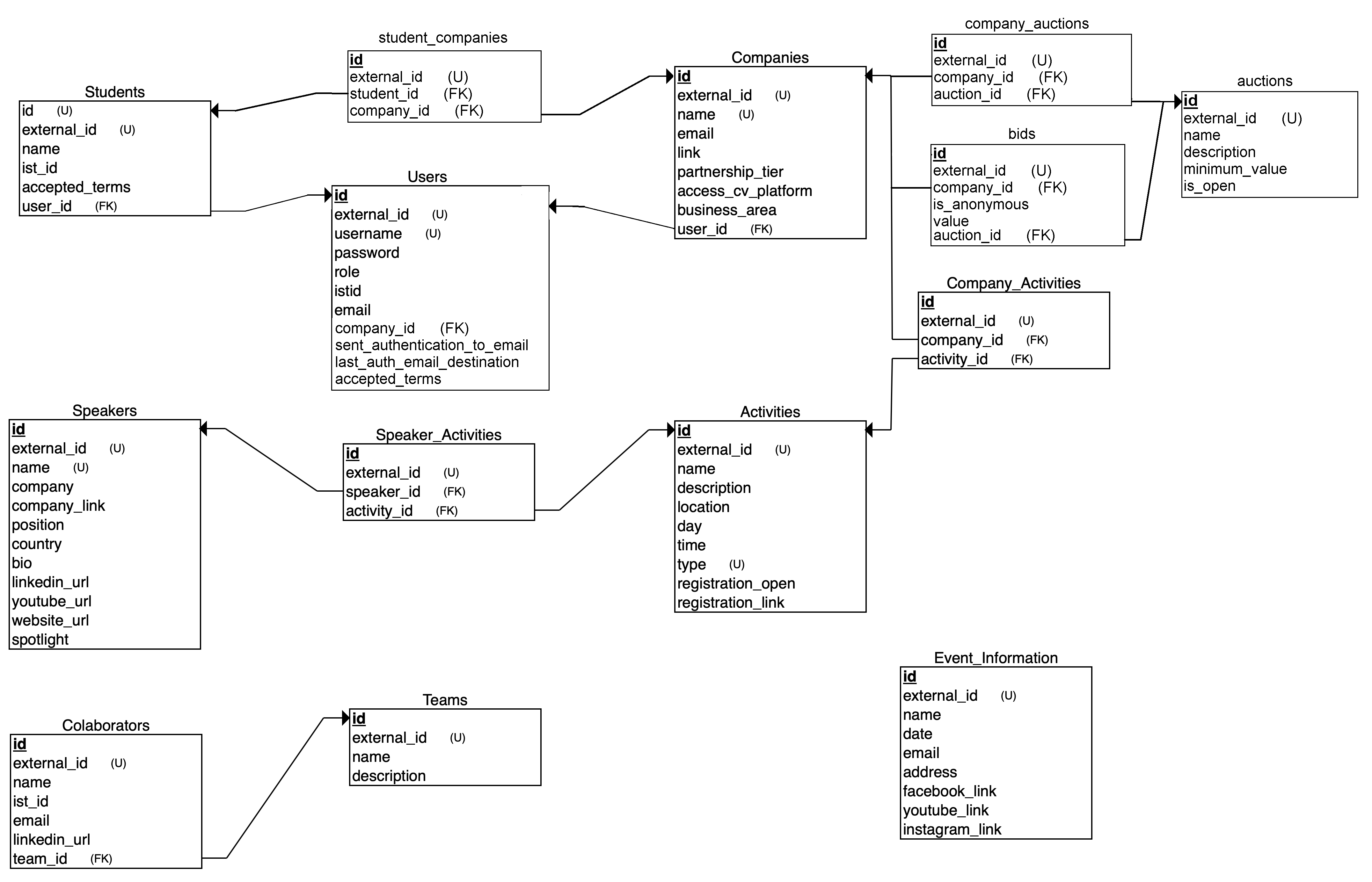- What is this?
- Administration App
- Companies App
- Website Api
- Tech Stack
- Instructions to deploy locally
- Database Model
- Running migrations
- Authentication
- Useful links
Welcome to the Brain! This system serves the purpose of managing all the technological services of an event, and serving both the applications for companies and attendees.
It includes an Administration Dashboard were a user can access in order to list/add/edit/delete companies, speakers, activities, teams and colaborators.
The system consists of 3 main REST API's
- Administration API
- Companies API
- Website API
This is were the requests to the administration endpoints are managed, which focuses on the creation, editing, deletion and listing of data related to the event.

Companies:
list/add/edit/deletecompanies;- search companies;
- upload company logo;
- set partnership levels which include
main_sponsor/gold/silver/bronze;
Speakers:
list/add/edit/deletespeakers;- search speakers;
- upload speaker image;
- set spotlight speakers which will be instantly included in the homepage of the website
Teams:
list/add/edit/deleteteams;- search teams;
list/add/edit/deleteteam members;- search team members;
- upload team member image;
Activities: (workshops, tech talks, panel discussions, presentations, job fair, matchmaking)
list/add/edit/deletedifferent types of activities;- search activities (by type, name);
Auctions
list/add/edit/deleteauctions;add/removeauction participants
Users:
list/add/deleteadmin platform users;list/add/deletecompany app users;- search users
Available admin platform user roles:
admin: has permission to access, add, edit and delete every data in the platform;companies_admin: has permission to access activities, teams, speakers and companies, but only edit, add and remove companies;speakers_admin: has permission to access activities, teams, speakers and companies, but only edit, add and remove speakers;teams_admin: has permission to access activities, teams, speakers and companies, but only edit, add and remove teams;activities_admin: has permission to access activities, teams, speakers and companies, but only edit, add and remove activities;viewer: only has permission to view activities, teams, speakers and companies.
This API serves the companies app.

Auctions
Companies are able to access auctions that they are registered in. This dashboard allows to bet in the auction, check the participants and list the bets that this company made.
Resumes
Companies have access to the resumes submited by students. This dashboard allows to download them.
This endpoints are used to present data to the JEEC website. The website requests the companies, speakers, activities and teams data to this API.
Includes endpoints to:
GETspeakersGETactivitiesGETcompaniesGETteams
All the endpoints support search parameters, so for instance, a request can be made as:
GET /website/speakers?spotlight=False
and only the spotlight speakers will be requested. This enables search queries to the endpoints using different variables.
- Python 3.6
- Flask
- PostgreSQL
- Clone this repository;
- Install PostreSQL;
- Run the database service with:
sudo service postgresql start
- Create a new role in postgresql with all privileges:
sudo -u postgres -ipsql postgresCREATE ROLE '<your-computer-account-username>' WITH PASSWORD '<password>'GRANT ALL PRIVILEGES ON SCHEMA public TO ROLE '<your-computer-account-username>'\qexit
- Create a database in postgresql for the application:
psql postgresCREATE DATABASE brain;
- Create a file in the root of the project named ".env" and fill in the missing variables:
SECRET_KEY=somethingsomethingkey21313 APP_ENV=development FLASK_DEBUG="True" # Database (update APP_DB with the name of your database) APP_DB = DATABASE_URL = "postgresql:///" # File submission CV_SUBMISSION_OPEN = "FALSE" UPLOAD_FOLDER = '/jeec_brain/storage/' # Credentials required to access the Website API CLIENT_USERNAME = CLIENT_KEY =
docker build --tag brain:latest .docker run -p 8081:8081 --name brain_1 -d brain:latest
-
Create virtual environment and install required dependencies with:
python3.6 -m virtualenv venvsource venv/bin/activatepython3.6 -m pip install -r requirements.txt
-
Ask Devs for the fenixedu.ini file and insert it in the root of the project
-
Migrate the database with:
python3.6 manage.py db initpython3.6 manage.py db migratepython3.6 manage.py db upgrade
-
Create a new amin user:
python3.6 manage.py create_user --username johndoe --role admin- The script then prints the password of the user.
-
Deploy the Flask application using Gunicorn with:
exec gunicorn --config deployment/gunicorn_config.py manage:app
The application runs on port 8081.
- Data migrations are ran using the commands:
python manage.py db migratepython manage.py db upgrade
The Administration API and the Companies API use session Authentication, implemented by flask_login library and cache. Users must be created in the database, and then provide their username and password to acess the system.
Management users are added in the admin users dashboard. Passwords are generated automatically.
- Roles: Each user has a role in the system, which will define the actions that this user is allowed to perform.
Company users must be added in the Admin platform. The company of the user must be provided, as long as the username. Passwords are automatically generated.
When it comes to Website API, the autentication used is BasicAuth. So, we set the credentials in the .env file, and the website must provide this credentials in the headers of the requests, in order to get authenticated and be able to access the data.
- Article about the Single Responsability Principle which is the main design pattern that this code follows - https://medium.com/unbabel/refactoring-a-python-codebase-using-the-single-responsibility-principle-ed1367baefd6
- Flask Documentation - http://flask.pocoo.org/docs/1.0/
- The most complete Flask Tutorial ever - https://blog.miguelgrinberg.com/post/the-flask-mega-tutorial-part-i-hello-world

